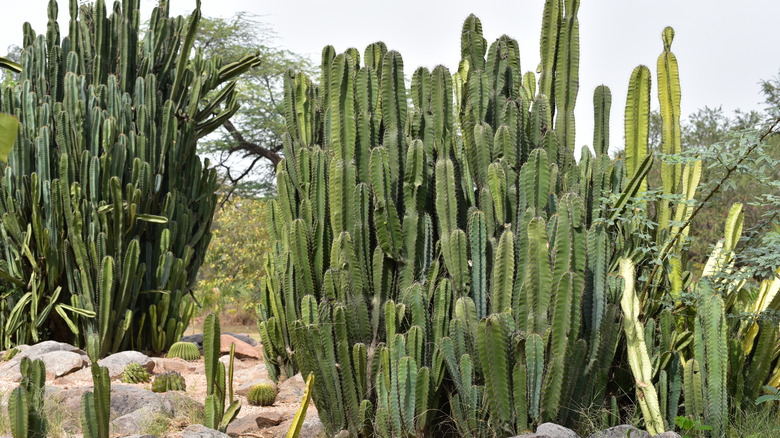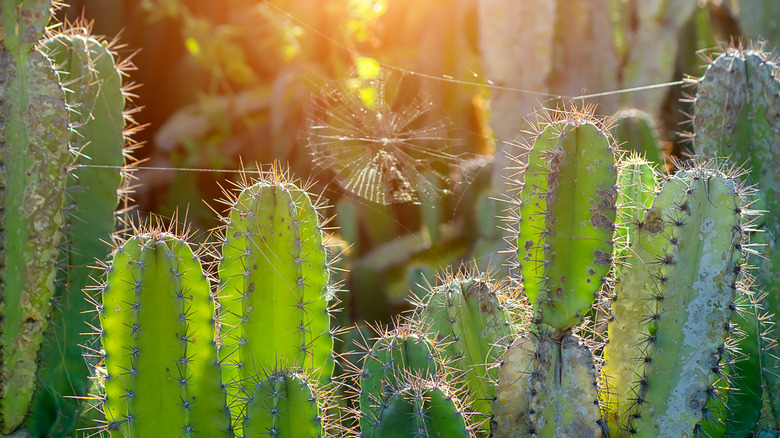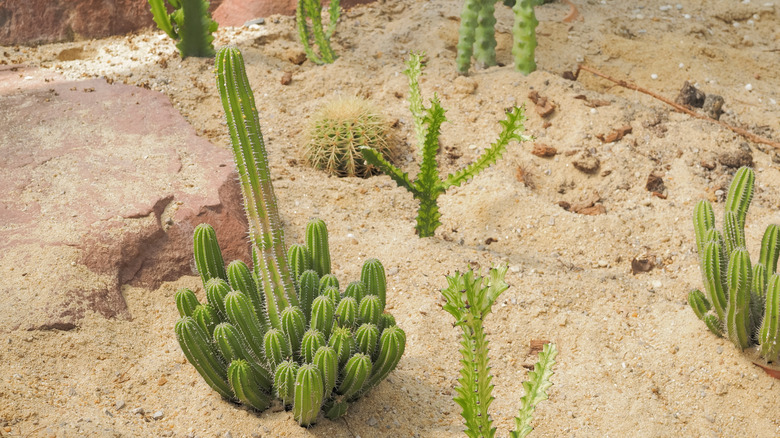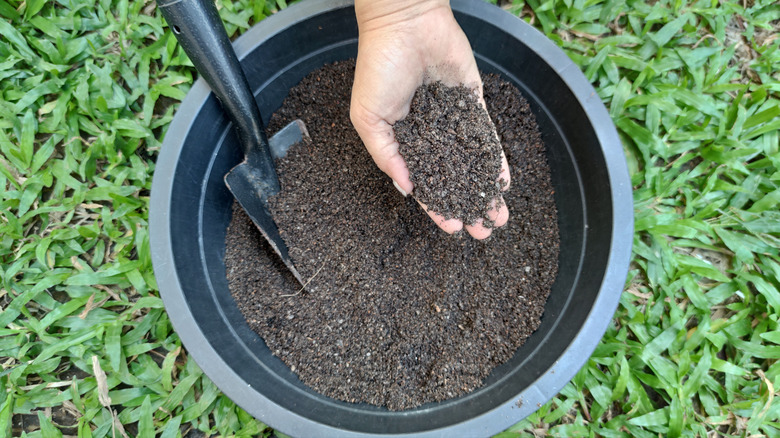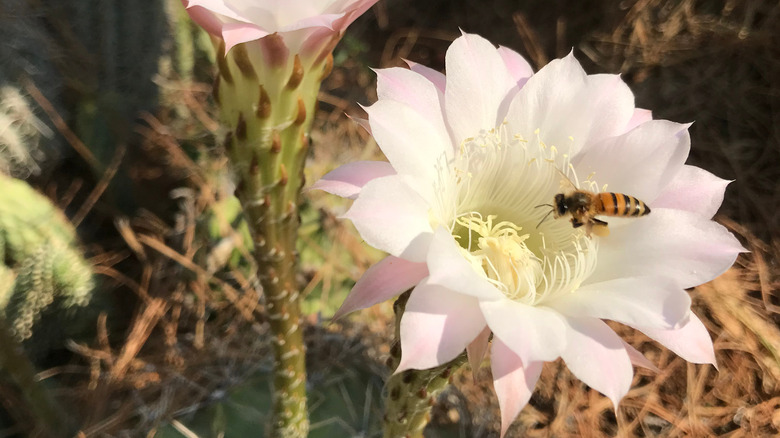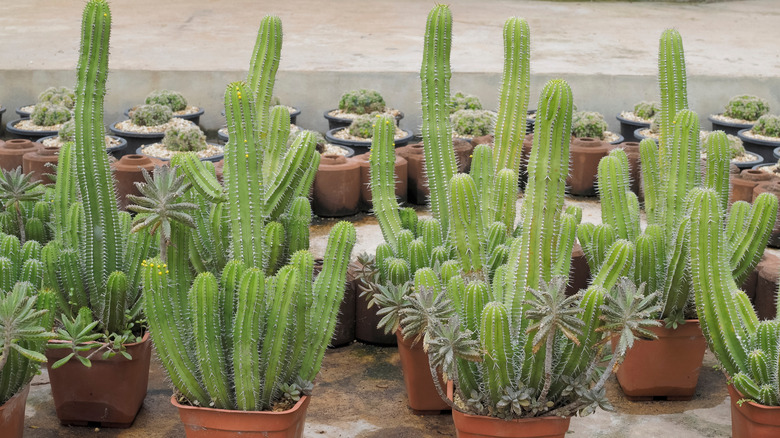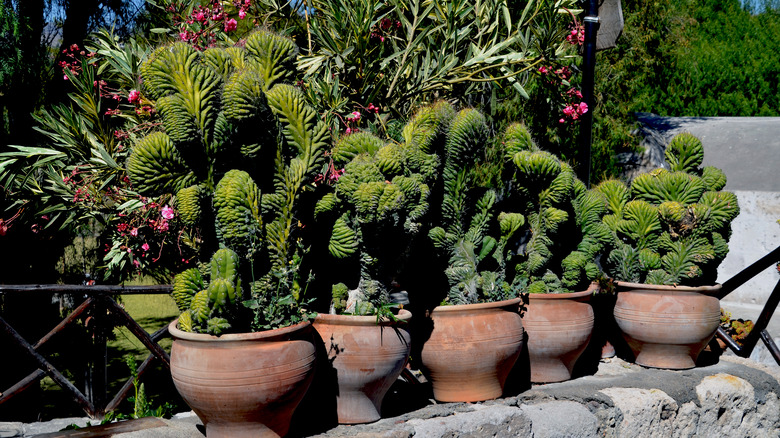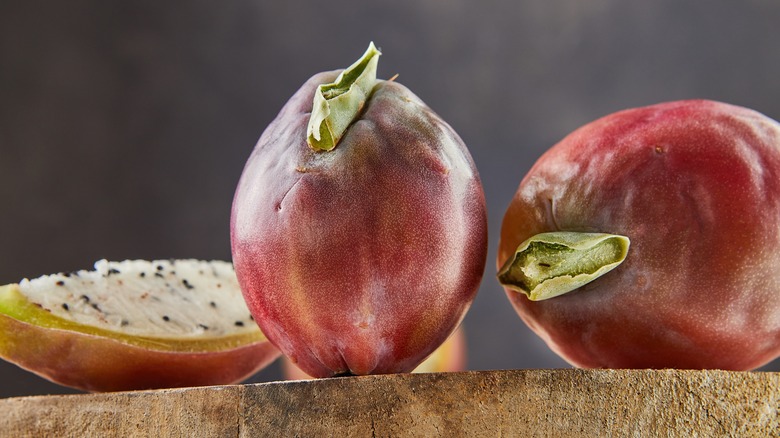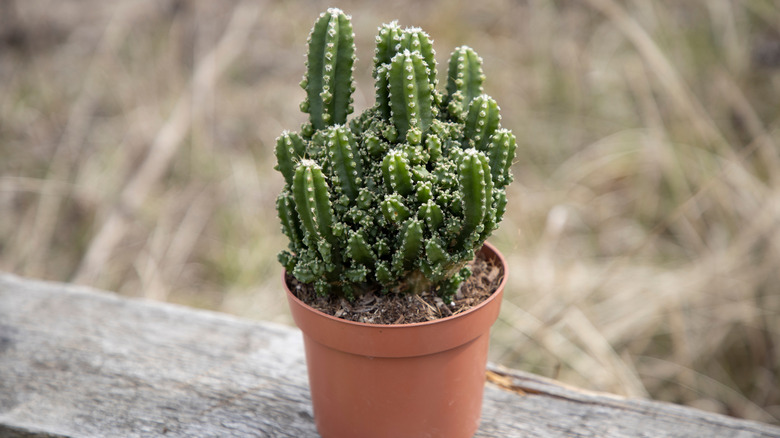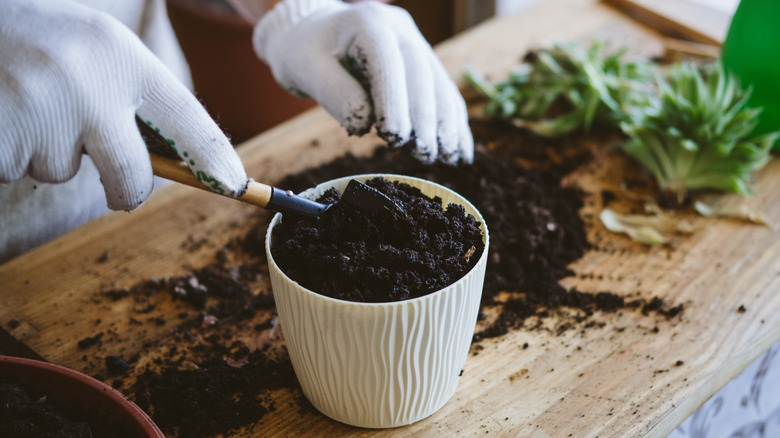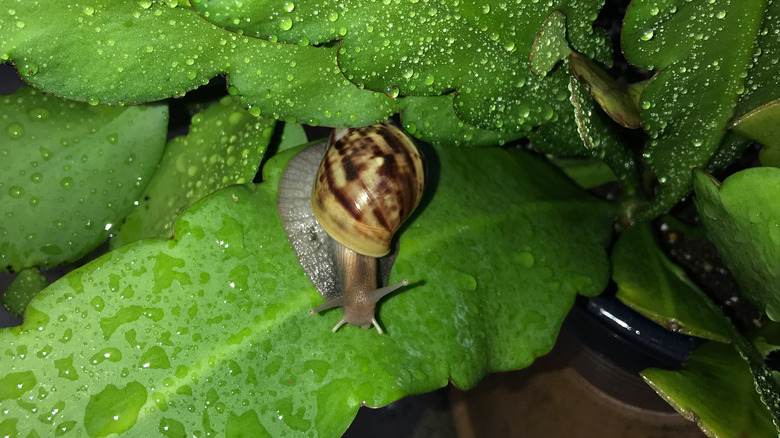How To Grow And Take Care Of A Peruvian Apple Cactus
The Peruvian apple cactus (classified as Cereus peruvianus, Cereus Uruguayanus, or Cereus Repandus) is a column-style cactus, sometimes with as many as five blades. It is armed with thorns and brown spines. The plant has a thick, cylindrical stem capable of storing water, which is key to the cactus's survival in arid areas. The bluish-green plant generates white flowers up to 7 inches across. They bloom at night or early morning, inspiring the cactus's nicknames, Queen of the Night and Princess of the Night. It is also known as a column, hedge, or night-blooming cactus, per House Plants Expert. The plant produces a sweet and succulent fruit packed with seeds, and the cactus can also be eaten raw when ripe.
It is native to Brazil, Paraguay, Uruguay, and Argentina (but not Peru!). The cactus grows in Florida, Arizona, Southern California, and parts of the Caribbean and is widely cultivated in Israel.
How to use Peruvian apple cactus in garden
The Peruvian apple cactus can serve as a dramatic centerpiece to your garden given its height. It will be a colorful addition to more neutral surroundings. As with other cacti, it is best to situate it alongside plants with similar growing requirements. However, CactusWay points out that the cactus can also put the finishing touches on an area that is unsuitable for more delicate plants. The outlet singles out the Mountain Pepper, a shrub that can reach 13 feet, as a good garden companion. A rock garden is also an appropriate setting for the Peruvian apple cactus. Lastly, it can also reside in a greenhouse or be used as ornamentation at the front of a building.
Generating multiple flowers and producing more abundant fruit are the goals of many cactus growers. Gardening Know How suggests this can be accomplished by planting your cacti in large groupings. When choosing where to place your cactus, make sure that a location with direct sunlight is your priority.
How to grow Peruvian apple cactus
Typical of cacti and succulents, the Peruvian apple cactus can be propagated by offsets — also known as pups, or the daughter plants of the mother cactus. These offshoots grow from the mature plant's base. The offset should be excised using a sharp and sterile knife. Gently remove excess soil and let several days elapse before replanting. This will permit the wound to heal and callus. Sulfur powder can be applied to the cut to serve as a fungicide. House Plants Expert also suggests propagation can be accomplished using cuttings from a mature cactus's stem top.
The Peruvian cactus can be propagated with seeds as well. However, using offsets is considered the more straightforward method and is preferable due to the plant's slow growth rate, as per Succulents Network. Propagating using seeds can be done outside, weather permitting. The optimal temperature range is between 70 and 80 degrees Fahrenheit for seeding outdoors. Care should be taken to protect seedlings from exposure to direct sun. Whatever propagation method is employed, your new cactus will thrive in peat-based compost that drains well.
How quickly will a Peruvian apple cactus grow?
A Peruvian apple cactus is a slow-growing variety. According to Justagric, the plant only grows about two to four feet per year with proper care. It will grow towards its light source, so rotate it regularly for even growth. The plant is low-maintenance, but applying a nutrient-rich fertilizer can help maximize growth. When grown in containers indoors, they can grow to about five or six feet tall (via PlantVine). However, mature Peruvian apple cacti growing in the wild can reach about 30 feet.
If your cactus is failing to grow and thrive, the problem is likely overwatering or soil issues (via Epic Gardening). The plant's growth accelerates during the spring and summer when it's fruiting, so a little extra water can help foster additional growth. Make sure to lower the amount for cooler months since the plant won't need as much energy. No matter the season, allow the soil to almost fully dry out between waterings. Soil that's not draining well can also inhibit growth. Stir some perlite or sand into your soil to help aid drainage. As your cactus grows, don't forget to move it to a bigger container to accommodate its larger size.
When will a Peruvian apple cactus bloom?
The Friends of the Port St. Lucie Botanical Gardens point out that the Peruvian apple cactus blooms throughout the late spring and early fall. The fragrant flowers are about two or three inches in diameter. They also come in various hues, from white to dusty pink.
You'll have to rise early or take an evening stroll to see the Peruvian apple cactus in bloom (via Owlcation). The flowers are nocturnal and open only for a few hours, just before either sunrise or dusk. And you don't want to miss the blooms. They only have a one-day lifespan, with each flower opening once for a short time before dying off. Because these blooms open at night, Peruvian apple cacti are often pollinated by nocturnal animals like moths and bats (via Cape Gazette). To simulate the process in your home, you can use a small paintbrush to hand-pollinate the flowers.
How to care for Peruvian apple cactus
A minimum of eight hours of medium to full sunlight is optimum, and your Peruvian apple cactus will flourish in areas devoid of significant rainfall. Whether inside or out, the cactus is easy to care for. As a houseplant, there are some general rules to follow. Place it near a well-lit window in a room that is adequately ventilated. Rotate the plant if it begins to lean toward the light source. Make sure the ceiling is high enough to accommodate a mature plant, and be aware that constant pruning may be necessary to keep the plant in check.
Gardenine asserts that cacti do not need nutrient-rich soil to thrive, and you can boost your plant with a fertilizer rich in potassium, nitrogen, and phosphorous. Properly watering the cactus ensures a healthy plant. Minimal water is required, especially in the dormant winter phase. Make sure soil is dry before watering, as over-watering may invite root rot and ultimately prove fatal. Spongy blades and stems are a signal the plant requires water. Fertilize in springtime. An indoor plant may be susceptible to spider mites, aphids, or scales while its outdoor brethren may be harmed by snails, slugs, or mealybugs. Epic Gardening recommends counterattacking by using organic insecticides or rubbing the cactus with cotton soaked in alcohol.
Varieties of Peruvian apple cactus
An estimated 33 different varieties of apple cactus plants have been identified, according to Gardenine. There are seven night-blooming genera.
Some common varieties of the Peruvian Apple Cactus include:
- Cereus Jamacara: This type has yellow spines, versus the brown ones of Cereus Peruvianus. The stems lack thorns, and the flowers are more diminutive than those of its counterpart.
- Cereus Peruvianus var. Monstrosus: It is also known as the curiosity plant or Montrose apple cactus. Huge fruits distinguish this variety.
- Cereus Hildmannianus Montrose: This South American mammoth can reach 33 feet in height. The so-called fairy castle cactus (Acanthocereus Tetragonus) is recognized as a cultivated version of this type.
- Cereus Tetragonus: This is a North American species that also comes in a dwarf variety.
- Cereus Jamacandu: A Brazilian cactus that tends to be shorter (maximum height of 20 feet) than Cereus Peruvianus. It also goes by the names, Cardeiro and Mandacaru.
Are Peruvian apple cacti toxic?
The Peruvian apple cactus is neither poisonous nor does it have psychoactive properties. It does produce an edible fruit that is both delicious and filled with beneficial vitamin C, beta-carotene, and fiber. The fruit is roughly the size of a conventional apple, and its white and seed-filled interior is similar in appearance to dragon fruit. The Peruvian apple is called pitaya in its native South America, where it is a dietary favorite of birds, insects, and reptiles, not to mention humans. The cactus, with its minimal water requirements, is now cultivated in Israel. According to Specialty Produce, the fruit has become a significant crop in this arid country and is sold there and elsewhere as the Koubo fruit.
A cactus can absorb household radiation, and its fierce spines represent the only threat of this non-toxic plant. Care needs to be taken when transporting it to avoid getting speared or having the thorns stick to your clothes. Accordingly, a household with young children or pets may not be an appropriate location for the Peruvian apple cactus.
How to repot Peruvian apple cactus
Make sure to don protective gloves when handling your cactus. A younger one may require frequent repotting, which can be done each year and should take place in the spring. Later, repot only as needed, graduating to a slightly larger container each time (via House Plants Expert). The Cereus Peruvianus is a hefty plant. The stems retain water and increase the plant's weight, potentially making a mature plant difficult to lift and move. A heavy and sturdy container is recommended to guard against your weighty specimen falling over.
To repot, add a combination of rocks and gravel to the bottom of the new pot for drainage. Top this layer with your soil or cactus mix. Gently remove existing soil from the plant's root ball. Then place the cactus into its new container and add more soil. CactusCare urges caution when handling the plant's base to prevent damage, or later, disease. Once repotted, leave the cactus untouched for a week or so, then water. If desired, your potted plant can eventually be moved outdoors, but be sure to return it inside as conditions warrant and temperatures plummet.
How to prune a Peruvian apple cactus
SFGate recommends pruning your Peruvian apple cactus for a few reasons. First, you'll want to quickly trim off any diseased or damaged branches to keep issues from spreading. Also, the large plant can soon outgrow its indoor home. Trimming smaller cacti can be a DIY project unless you have a very large plant that requires professional help. First, dress in protective clothing and gloves as well as goggles when pruning your cactus. Using a knife or pruning saw, carefully cut branches where they connect to the trunk or split from another branch. You can also trim branches where a knob has formed to divide sections of growth.
Healthy cuttings and offshoots can be used to produce new cacti (via Cape Gazette). Look for small offshoots sprouting up in your pot. You can simply dig these up and replant them in their own containers. To propagate cuttings, use pieces from the top of the stem. Allow them to dry out before planting them to start new cacti.
Should you cover a Peruvian apple cactus during cold weather?
Peruvian apple cacti are hardy in USDA zones 9 through 11, but Horticulture Unlimited recommends covering entire outdoor plants during severe cold temperatures. They can withstand temperatures above 18 degrees but will freeze uncovered in temperatures below that. Use burlap or thin sheets to cover your cactus and gently tie the fabric in place (via Arizona Cactus Sales). Even in warmer winter temps, you can still offer your growing cactus protection. Styrofoam cups can provide insulation to the tips of the plant, where the new growth makes them more vulnerable.
The plant prefers temps between 50 and 70 degrees. It will benefit most from a range between 50 and 55 degrees and low humidity in the winter months (via Plantly). If you live in a coastal climate, keeping your cactus outside might be possible. If not, this makes an indoor home near a window and a heat vent perfect for your cactus.
Peruvian apple cactus pests and diseases
Plant Care Today points out that cacti can suffer from mealybug infestations when the soil is kept too damp. Avoid these pests by allowing your soil to dry out between watering and ensuring indoor apple cacti aren't kept in humid environments. Once these bugs make your plant a home, they multiply quickly and destroy it by diminishing the moisture. To get rid of mealybugs, you can spray your cactus down or rinse it with a solution of castile soap and water. You can also apply neem oil spray or wipe the branches down with isopropyl alcohol.
Slugs and snails can also be problematic for Peruvian apple cacti. They are typically nocturnal and rapidly reproduce (via BugWiz). It's important to remove snails, slugs, and their eggs from your plant as soon as you see them. You can also add companion plants that deter them near your cacti to protect them. This includes ferns, hydrangeas, lavender, and yucca, among others.
Root rot is another detrimental condition to avoid (via PictureThis). Your cacti could suffer from this when the soil is too moist and impermeable. To prevent this, make sure to change your cacti's soil each year and loosen it regularly so air can circulate.
Where to buy a Peruvian apple cactus
One place you can start your search is your local nursery or greenhouse. Depending on the area you live in, they might be well stocked with quality cacti, including the Peruvian apple variety. Earth.com suggests checking out a prospective nursery's website or calling them before you visit. Schedule your visit for a weekday to avoid crowds, especially if you'd like help from an attentive staff member.
When selecting your cactus, make sure the soil is dry and well drained. The last thing you want is to buy a cactus that's been habitually overwatered (via CostaFarms). Look at the plant from all sides to check for even growth and inspect branches for any damage before purchasing.
You can also opt to order your cactus online. This is a good option that gives you access to a wide variety at different price points (via CactusWay). Many online greenhouses will ship your new cactus straight to your home and provide helpful customer service, including care tips. Look for a product guarantee to be more confident in your new purchase.
